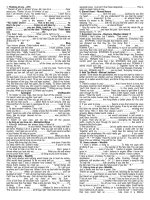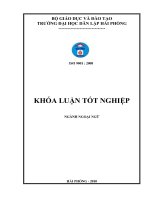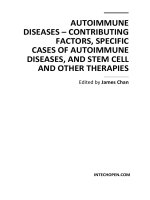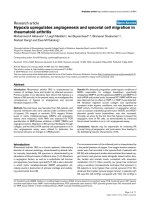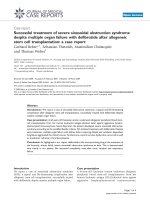Mechanisms of neurodegeneration and stem cell migration a study of molecular signals in the model of axotomy
Bạn đang xem bản rút gọn của tài liệu. Xem và tải ngay bản đầy đủ của tài liệu tại đây (9.3 MB, 288 trang )
MECHANISMS OF NEURODEGENERATION AND STEM CELL
MIGRATION: A STUDY OF MOLECULAR SIGNALS
AFTER PERIPHERAL NERVE INJURIES
JI JUN FENG
MBBS
A THESIS SUBMITTED FOR THE DEGREE OF
DOCTOR OF PHILOSOPHY
DEPARTMENT OF ANATOMY
FACULTY OF MEDICINE
NATIONAL UNIVERSITY OF SINGAPORE
2004
i
ACKNOWLEDGMENTS
I would like to express my deepest appreciation to my supervisor, Associate
Professor Samuel Sam Wah Tay, Department of Anatomy, National University of
Singapore, for his innovative ideas, invaluable guidance, constant encouragement,
infinite patience, and friendly critics throughout this study.
I am greatly indebted to Assistant Professors S. Thameem Dheen and He Bei
Ping, Department of Anatomy, National University of Singapore, for their valuable
suggestions and friendly help during this study.
I am very grateful to Professor Ling Eng Ang, Head of Anatomy Department,
National University of Singapore, for his constant support and encouragement to me, and
also for his full support in using the excellent research facilities.
I must also acknowledge my gratitude to Mrs Ng Geok Lan, Mrs Yong Eng
Siang and the late Miss Margaret Sim for their excellent technical assistance; Mr Yick
Tuck Yong for his constant assistance in computer work; Mr P. Gobalakrishnan for his
constant guidance in photomicrography; Mr Tajuddin B. Marican Ali for his help in
animal operation; Mr Lim Beng Hock for looking after the experimental animals; Miss
Teu Cheng Hong Kate for her assistance in cell culture work; and Mdm Ang Lye Gek
Carolyne, Mdm Diljit Kaur, Mdm Teo Li Ching Violet for their secretarial assistance.
I would like to thank all other staff members and my fellow postgraduate students
at Department of Anatomy, National University of Singapore for their help and support.
I would like to express my special thanks to my friends, Drs.Ouyang Hongwei
and Wang Zhuo at Department of Orthopaedic Surgery, National University Hospital for
their friendly help and advice.
ii
Certainly, without the financial support of the National University of Singapore,
which offered a research grant (R181-000-059-213), this work would not have been
brought to a reality.
I would like to take this opportunity to express my heartfelt thanks to my parents
and sister for their full and endless support for my study.
Finally, I am greatly indebted to my wife, Mdm Yu Xiao Liang for her
understanding and encouragement during this study.
iii
This thesis is dedicated to
my beloved family
iv
PUBLICATIONS
Various portions of the present study have been published or accepted for publication.
International Jounals:
1. Ji J, Dheen ST, Tay SSW (2002). Molecular analysis of vagal motoneuronal
degeneration after right vagotomy. J Neurosci Res 69 (3): 406-17.
2. Ji JF, He BP, Dheen ST, Tay SSW (2004). Expression of chemokine receptors
CXCR4, CCR2, CCR5 and CX
3
CR1 in the neural stem cells isolated from the
subventricular zone of the adult rat brain. Neurosci Lett 355 (3): 236-40.
3. Ji JF, He BP, Dheen ST, Tay SSW (2004). Interactions of chemokines and
chemokine receptors mediate the migration of bone marrow stromal cells to the
impaired sites in the brain after hypoglossal nerve avulsion. Stem Cells 22 (3): 415-
27.
4. Ji JF, Dheen ST, Tay SSW. Expressions of cytokines and chemokines in the dorsal
motor nucleus of the vagus of the rat after right vagotomy. (Submitted).
Conference papers:
1. Ji JF, Dheen ST, Tay SSW (2002). Upregulation of inducible nitric oxide synthase
and its mRNA expression in vagal motor nuclei following right vagotomy in rat.
Australia Neuroscience Society Meeting, Sydney, Australia.
2. Ji JF, Dheen ST, Tay SSW (2002). Activation of apoptotic and N-methyl-D-
aspartate (NMDA) receptor-calcium-neuronal nitric oxide synthase (nNOS)
pathways in the vagal motor nuclei of rats after right vagotomy. Annual Meetings of
Experimental Biology, New Orleans, LA, USA.
3. Ji JF, Dheen ST, Tay SSW (2002). Site-specific migration of transplanted
mesenchymal stem cells into the hypoglossal nucleus after unilateral avulsion of
hypoglossal nerve. Society for Neuroscience 32
nd
Annual Meeting, Orlando,
Florida, USA.
v
4. Ji JF, He BP, Dheen ST, Tay SSW (2003). Expressions of chemokine receptors on
neural stem cells from adult rat brains. Society for Neuroscience 33
rd
Annual
Meeting, New Orleans, LA, USA.
5. Ji JF, He BP, Dheen ST, Tay SSW (2004). Expression of cytokines in the dorsal
motor nucleus of the vagus nerve after vagotomy. 4
th
ASEAN Microscopy
Conference, Hanoi, Vietnam.
vi
TABLE OF CONTENTS
ACKNOWLEDGEMENTS…………………………………………………………… i
DEDICATIONS…………………………………………………………………………iii
PUBLICATIONS……………………………………………………………………… iv
TABLE OF CONTENTS……………………………………………………………….vi
ABBREVIATIONS…………………………………………………………………….xvi
SUMMARY…………………………………………………………………………… xx
CHAPTER 1: INTRODUCTION……………………………………………………….1
1. General introduction: Animal model of axotomy to study neurodegeneration 2
2. Neuronal and glial responses to axotomy…………………………………………… 2
2.1. Axonal reaction………………………………………………………………… 2
2.1.1. Morphological changes in nerve fibre………………………………………2
2.1.2. Changes in axonal transport…………………………………………………3
2.2. Perikaryal alteration……………………………………………………………… 4
2.2.1. Morphological changes…………………………………………………… 4
2.2.2. Metabolic changes………………………………………………………… 5
2.3. Glial cell reaction………………………………………………………………… 6
2.4. Fate of axotomized neurons 7
3. Neuronal death after axotomy………………………………………………………… 8
3.1. Apoptosis 8
3.1.1. Discovery of apoptosis…………………………………………………… 8
3.1.2. Morphological characteristics of apoptotic cell death………………………8
vii
3.1.3. Apoptosis in the model of axotomy……………………………………… 9
3.2. Necrosis……………………………………………………………………………9
4. Mechanisms of neurodegeneration……………………………………………………10
4.1. Involvement of Cytokines 10
4.1.1. Pro-inflammatory cytokines tumor necrosis factor alpha (TNF-α)
and interleukin-1 beta (IL-1β) ………………………………………… 11
4.1.2. Interleukin-6 (IL-6)……………………………………………………… 13
4.1.3. Transforming growth factor-beta 1 (TGF-β1)…………………………… 14
4.2. Role of Nitric oxide (NO) in neurodegeneration.……………………………… 14
4.2.1. Historical perspective of NO.…………………………………………… 14
4.2.2. Isoforms of nitric oxide synthase (NOS).………………………………….15
4.2.3. Biological functions of NO.……………………………………………… 16
4.2.4. Roles of NO in the nervous system.……………………………………… 16
4.2.5. Roles of NO in the model of axotomy.…………………………………….19
4.3. Involvement of apoptosis associated molecules.…………………………………19
4.3.1. Bcl-2 and Bax.…………………………………………………………… 19
4.3.1.1. Discovery of Bcl-2 and Bax 19
4.3.1.2. Functions of Bcl-2 and Bax in apoptosis.…………………………20
4.3.1.3. Bcl-2 and Bax in the model of axotomy.………………………….21
4.3.2. Caspase-3.………………………………………………………………….22
4.3.2.1. Discovery of caspases.…………………………………………….22
4.3.2.2. Functions of caspase-3 in apoptosis.………………………………23
4.3.2.3. Caspase-3 in the model of axotomy.………………………………23
viii
4.4. N-methyl-D-aspartate receptor (NMDAR)-calcium-neuronal nitric
oxide synthase (nNOS) pathway in neurodegeneration…………………………24
4.4.1. Functions of NMDAR ………………………………………………… 24
4.4.2. Calbindin D28 K (CB) 25
4.4.3. nNOS ……………………………………………………………………26
4.5. Chemokines/chemokine receptors……………………………………………….27
4.5.1. Historical discovery of chemokines/chemokine receptors……………… 27
4.5.2. Chemokines/chemokine receptors in the normal central nervous
system (CNS) 28
4.5.2.1. Chemokines/chemokine receptors and brain development……….28
4.5.2.2. Chemokines/chemokine receptors in the normal adult brain…… 29
4.5.3. Roles of chemokines/chemokine receptors in neurodegeneration……… 30
4.5.3.1. Stromal Cell-Derived Factor 1 (SDF-1)………………………….30
4.5.3.2. Fractalkine……………………………………………………… 31
4.5.3.3. Monocyte Chemoattractant Protein 1 (MCP-1)………………… 32
5. Animal model of the present study for molecular analysis of
neurodegeneration: vagotomy…………………………………………………………34
5.1. Structure and function of the vagus nerve system.……………………………….34
5.2. Degeneration of the vagal motoneurons in the model of vagotomy…………… 37
6. Cell replacement in the CNS: potential neuroregeneration by stem cells…………….38
6.1. Mesenchymal Stem Cells (MSCs)……………………………………………… 38
6.1.1. Historical discovery of MSCs…………………………………………… 38
6.1.2. Biological characteristics of MSCs……………………………………… 39
ix
6.1.2.1. Heterogeneity of MSCs……………………………………………39
6.1.2.2. Expression of cytokines by MSCs……………………………… 40
6.1.2.3. Proliferation and multipotent differentiation of MSCs……………40
6.1.3. Transdifferentiation of MSCs into neurons and glia……………………….41
6.1.4. Therapeutic potential of MSCs to treat CNS diseases and injuries……… 42
6.1.5. Directed migration of transplanted MSCs…………………………………43
6.1.6. Mechanisms of cell migration: role of chemokines/chemokine receptors 43
6.1.6.1. SDF-1/CXCR4…………………………………………………….44
6.1.6.2. Fractalkine/CX
3
CR1………………………………………………45
6.1.6.3. MCP-1/CCR2…………………………………………………… 45
6.1.7. Animal model of the present study of MSCs migration: unilateral
avulsion of the hypoglossal nerve….…………………………………… 46
6.1.7.1. Structure of the hypoglossal nerve system……………………… 46
6.1.7.2. Unilateral avulsion of the hypoglossal nerve…………………… 47
6.2. Adult neural stem or progenitor cells……………………………………………48
6.2.1. Historical discovery of neural stem or progenitor cells in the adult brain 48
6.2.2. Neural stem or progenitor cells in the subventricular zone (SVZ)……… 49
6.2.2.1. Origin of the postnatal SVZ………………………………………49
6.2.2.2. Architecture of the SVZ………………………………………… 49
6.2.2.3. Identity of neural stem or progenitor cells in the SVZ………… 50
6.2.3. Migration of endogenous neural stem or progenitor cells……………… 51
6.2.3.1. Migration of endogenous neural stem or progenitor cells
in the SVZ……… ……………………………………………….51
x
6.2.3.2. Migration of transplanted neural stem or progenitor cells……… 52
6.2.4. Mechanisms of the migration of neural stem or progenitor cells
in the SVZ …………………………………………………………… 53
6.2.4.1. Cell contact-mediating molecules……………………………… 53
6.2.4.2. Soluble factors……………………………………………………54
6.2.5. Roles of chemokines in the migration of neural stem or progenitor cells 54
7. Aims of the present study…………………………………………………………… 55
7.1. Molecular analysis of the degeneration of the vagal motoneurons in the DMV
after right vagotomy.…………………………………………………………… 55
7.2. Molecular analysis of the interactions of chemkines and chemokine receptors
in mediating the migration of rMSCs to the impaired site in the brain after
hypoglossal nerve avulsion.………………………………………………………58
7.3. Investigation of expression of chemokine receptors by neural stem or
progenitor cells isolated from the SVZ of the adult rat brain as the
potential mechanism of their migration …………………………………………60
CHAPTER 2: MATERIALS AND METHODS…………………………………… 62
1. Animals……………………………………………………………………………….63
2. Right vagotomy………………………………………………………………………63
3. Avulsion of the left hypoglossal nerve……………………………………………….64
4. Histology 64
4.1. Perfusion………………………………………………………………………….64
4.2. Tissue preparations………………………………………………………………65
xi
4.3. Histochemistry………………………………………………………………… 67
4.3.1. Nissl staining with cresyl fast violet (CFV)……………………………….67
4.3.2. NADPH-d histochemistry…………………………………………………68
4.3.3. Lectin histochemistry…………………………………………………… 68
5. TUNEL method………………………………………………………………………69
6. In situ hybridisation………………………………………………………………… 69
6.1. Labelling probes with digoxigenin………………………………………………70
6.2. In situ hybridisation.…………………………………………………………… 71
7. Primary culture of rat MSCs (rMSCs)……………………………………………… 74
7.1. Fluorescent activated cell sorting (FACS) analysis…………………………… 76
7.2. In vitro differentiation assays…………………………………………………….78
7.3. In vitro chemotaxis assay……………………………………………………… 81
7.4. MTT (3-(4,5-dimethylthiazoyl-2-yl)2,5-diphenyltetrazolium-bromide) assay….83
7.5. Labelling of rMSCs………………………………………………………………84
7.5.1. Labelling of rMSCs with 5-(and-6)-carboxyfluorescein
diacetate succinimidyl ester (CFDA-SE)….………………………… 84
7.5.2. Transfection of rMSCs with enhanced green fluorescent protein-N1
(EGFP-N1) vector ……………………………………………………….85
7.6. In vivo rMSCs chemotaxis assay……………………………………………… 88
8. Primary culture of neural stem or progenitor cells………………………………… 89
8.1. In vitro differentiation assay…………………………………………………… 91
9. Primary culture of rat microglia…………………………………………………… 91
10. Propidium iodide (PI) staining.………………………………………………………92
xii
11. Immunohistochemistry/immunocytochemistry.…………………………………… 93
12. Reverse transcription polymerase chain reaction (RT-PCR).……………………… 98
12.1. RNA isolation 98
12.2. One step RT-PCR.…………………………………………………………… 99
12.3. Real time RT-PCR 102
13. Transplantation of rMSCs into lateral ventricles of the rat brain after left
hypoglossal nerve avulsion ……………………………………………………… 104
CHAPTER 3: RESULTS…………………………………………………………… 106
1. Molecular analysis of vagal motoneuronal degeneration after right vagotomy…….107
1.1. Morphological studies of vagal motoneurons in the DMV.……………………107
1.2. Expressions of cytokines TNF-α, IL-1β, IL-6, and TGF-β1 at mRNA
and/or protein levels in the DMV.… ………………………………………….109
1.2.1. mRNA expressions of TNF-α, IL-1β, and TGF-β1 in the right
brainstem ………… 109
1.2.2. Immunoreactivities of TNF-α, IL-1β, TGF-β1 and IL-6 in the DMV ….111
1.3. Expression of iNOS at mRNA and proteins levels in the DMV……………… 115
1.4. Activation of apoptotic pathway in the DMV after right vagotomy……………116
1.4.1. Expressions of Bcl-2 and Bax at both mRNA and protein levels……… 117
1.4.2. mRNA expression of Caspase-3…………………………………………118
1.4.3. TUNEL labeling in vagal motoneurons………………………………….118
1.5. Activation of NMDAR-Calcium-nNOS pathway in the DMV
after right vagotomy ………………………………………………………… 119
xiii
1.5.1. Expression of nNOS in the DMV ………………………………………119
1.5.2. Colocalization of nNOS with NMDAR1 and CB in the DMV ……… 120
1.6. Expressions of chemokines MCP-1, fractalkine and SDF-1 at mRNA
and/or protein levels in the DMV after right vagotomy …………………… 121
1.6.1. mRNA expressions of MCP-1 and fractalkine …………………………121
1.6.2. Immunoreactivities of MCP-1, fractalkine and SDF-1 in the DMV … 122
1.6.3. Colocalization of lectin with CX
3
CR1 staining ……………………… 124
2. Involvement of the interactions of chemkines and chemokine receptors
in the migration of rMSCs into the HN after nerve avulsion …………………… 125
2.1. Immunoreactivities of chemokines SDF-1, fractalkine and MCP-1 in the HN
after nerve avulsion…………………………………………………………… 125
2.2. In vitro characterization of rMSCs.…………………………………………….128
2.2.1. Morphology of rMSCs in vitro.………………………………………….128
2.2.2. Epitope analysis of rMSCs.………………………………………………128
2.2.3. The differentiation of rMSCs in vitro ………………………………… 129
2.3. Expressions of chemokine receptors CCR2, CCR5, CXCR4 and CX
3
CR1
in rMSCs at mRNA and protein levels ……………………………………….129
2.3.1. mRNA expressions of CCR2, CCR5, CXCR4 and CX
3
CR1 in rMSCs 130
2.3.2. Expressions of CCR2, CCR5, CXCR4 and CX
3
CR1 in rMSCs at the
protein level….………………………………………………………… 131
2.4. rMSCs migration to fractalkine and SDF-1α in heterotrimeric G protein
-dependent manner in vitro ……………………………………………………132
2.5. Labelling of rMSCs in vitro.……………………………………………………133
xiv
2.6. rMSCs migration to SDF-1 α in vivo ………………………………………… 133
2.7. Selective migration of transplanted rMSCs into the avulsed left HN ………….134
3. Expressions of chemokine receptors CXCR4, CCR2, CCR5 and CX
3
CR1 at
mRNA and protein levels in neural stem or progenitor cells isolated from the
SVZ of the adult rat brain ………………………………………………………….135
3.1. In vitro characterization of the cells isolated from the SVZ of the adult rat
brain 136
3.1.1. Morphology of the cells …………………………………………………136
3.1.2. The differentiation of the cells in vitro ………………………………….136
3.2. Neural stem or progenitor cells isolated from the SVZ of the adult rat
brain express CXCR4, CCR2, CCR5 and CX
3
CR1 ………………………… 137
3.2.1. mRNA expressions of CXCR4, CCR2, CCR5 and CX
3
CR1 in the
cells… 137
3.2.2. Colocalization of nestin with CXCR4, CCR2, CCR5 and CX
3
CR1 in
the cells………………………………………………………………… 138
CHAPTER 4: DISCUSSION…………………………………………………………139
1. Axotomy as model to study neurodegeneration…………………………………… 140
2. Factors and pathways involved in the vagal motorneuronal death………………….141
2.1. TNF-α and IL-1β……………………………………………………………… 141
2.2. iNOS-derived NO………………………………………………………………143
2.3. Apoptotic pathway…………………………………………………………… 144
2.4. NMDAR-calcium-nNOS pathway…………………………………………… 148
2.5. Chemokines…………………………………………………………………… 150
xv
2.5.1. MCP-1.………………………………………………………………… 150
2.5.2. Fractalkine.……………………………………………………………….152
2.5.3. SDF-1.……………………………………………………………………153
2.5.4. TGF-β1.………………………………………………………………… 154
2.5.5. IL-6.…………………………………………………………………… 155
3. Interactions between chemokines and their receptors in the directed migration
of rMSCs into axotomized HN.…………………………………………………… 158
3.1. SDF-1 and CXCR4…………………………………………………………… 160
3.2. Fractalkine and CX
3
CR1……………………………………………………… 162
3.3. MCP-1/CCR2 and other chemokines/receptors……………………………… 163
4. Expression of chemokine receptors in neural stem or progenitor cells isolated
from the SVZ of the adult rat brain ……………………………………………… 165
4.1. CXCR4………………………………………………………………………….167
4.2. CX
3
CR1……………………………………………………………………… 167
4.3. CCR2 and CCR5……………………………………………………………… 168
CHAPTER 5: CONCLUSION……………………………………………………….171
REFERENCES……………………………………………………………………… 175
Figures and Figure Legends
xvi
ABBREVIATIONS
ABC avidin-biotin complex
α-MEM alpha minimal essential medium
AMPA α-amino-3-hydroxy-5-methyl-4-isoxazolepropionate
AP alkaline phosphate
BBB blood-brain-barrier
CaBPs Ca
2+
binding proteins
CB calbindin D28K
CFV cresyl fast violet
CFDA-SE 5-(and-6)-carboxyfluorescein diacetate succinimidyl ester
CNS central nervous system
DAB 3,3’-diaminobenzidine tetrahydrochloride
DMV dorsal motor nucleus of vagus
DEPC diethyl pyrocarbonate
DMEM Dulbecco’s Modified Eagle’s Medium
EAE experimental autoimmune encephalomyelitis
eNOS endothelial nitric oxide synthase
EGF epidermal growth factor
FACS fluorescent activated cell sorting
GAPDH glyceraldehyde-3-phosphate dehydrogenase homolog
GFAP glial fibrillary acidic protein
GluRs glutamate receptors
HCl hydrochloric acid
xvii
HN hypoglossal nucleus
hMSCs human bone marrow stromal cells or human mesenchymal stem cells
HRP horseradish peroxidase
IEGs immediate early genes
IL-1 β interleukin-1 beta
IL-6 interleukin-6
IL-8 interleukin-8
IMDM Iscove’s Modified Dulbecco’s Medium
iNOS inducible nitric oxide synthase
MCP-1 monocyte chemoattractant protein 1
MIP-1 α macrophage inflammatory protein 1 alpha
mRNA messenger ribonucleic acid
MS multiple sclerosis
MSCs bone marrow stromal cells or mesenchymal stem cells
MTT 3-(4,5-dimethylthiazoyl-2-yl)2,5-diphenyltetrazolium-bromide
NA nucleus ambiguus
NADPH nicotinamide adenine dinucleotide phosphate
NCAM neural cell adhesion molecule
NeuN neuronal nuclei
NMDAR n-methyl-D-aspartate receptor
nNOS neuronal nitric oxide synthase
NO nitric oxide
xviii
NOS nitric oxide synthase
NSCs neural stem cells
NUMI National University Medical Institute, Singapore
OB olfactory bulb
PB phosphate buffer
PBS phosphate buffered saline
PCR polymerase chain reaction
PI propidium iodide
PNS peripheral nervous system
PSA-NCAM polysialylated form of neural cell adhesion molecule
RGC retinal ganglion cells
rER rough endoplasmic reticulum
rhSDF-1α recombinant human stromal cell-derived factor 1 alpha
RMS rostral migratory stream
rMSCs rat bone marrow stromal cells or rat mesenchymal stem cells
rrfractalkine rat recombinant fractalkine
RT-PCR reverse transcription polymerase chain reaction
SDF-1 stromal cell-derived factor 1
SVZ subventricular zone
TBS tris buffered saline
TdT terminal deoxynucleotidyl transferse
TGF-β transforming growth factor-beta
TNF tumor necrosis factor
xix
TNF-α tumor necrosis factor alpha
TUNEL terminal transferase-mediated deoxyuridine triphosphate-biotin nick end
labeling
WD Wallerian degeneration
SUMMARY
xx
Summary
Cytokines signalling, inducible nitric oxide synthase (iNOS) expression,
activation of apoptotic pathway and N-methyl-D-aspartate (NMDA) receptor-calcium-
neuronal nitric oxide synthase (nNOS) pathway, and chemokines expression in the vagal
motor nuclei after right vagotomy were examined. The results showed that vagal
motoneuronal degeneration as a result of vagotomy was confirmed from the observation
of a degenerative morphology and significant reduction in the number of neurons in the
vagal motor nuclei after right vagotomy. Upregulated immunoreactivities of tumor
necrosis factor-alpha (TNF-α), interleukin-1beta (IL-1β), interleukin-6 (IL-6), and
transforming growth factor-beta 1 (TGF-β1), significant increase in the numbers of their
immunopositive cells, and enhanced expression of TNF-α, IL-1 β and TGF-β1 mRNA in
the right dorsal motor nucleus of the vagus nerve (DMV) after operation were shown by
immunohistochemical, quantitative, and real-time PCR analysis, respectively. The
expression of iNOS protein and mRNA was induced in the DMV of vagotomized rats as
shown by immunohistochemistry, in situ hybridization and real-time PCR analysis. The
enhanced bcl-2 and reduced bax mRNA levels and subsequent upregulation of both bcl-2
and bax mRNA as well as protein level in the DMV of vagotomized rat were observed. In
addition, the increase of caspase-3 mRNA level was detected in ipsilateral vagal motor
nuclei after right vagotomy. Double immunofluorescence analysis showed complete co-
localization of nNOS with NMDAR1 and with Calbindin D28K (CB) in ipsilateral DMV
at 10 days following right vagotomy. The increased immunoreactivities of stromal cell-
derived factor 1 (SDF-1) and the upregulated expressions of monocyte chemoattractant
SUMMARY
xxi
protein 1 (MCP-1) and fractalkine at both the protein and mRNA levels in the right DMV
were shown by immunohistochemistry and/or real-time PCR analysis.
The roles of interactions between chemokines and their receptors in the
trafficking of rMSCs in the model of the left hypoglossal nerve avulsion were
investigated in the present study. We demonstrated the expressions of chemokine
receptors CXCR4, CCR2, CCR5, and CX
3
CR1 by rMSCs at the mRNA and protein
levels. Recombinant human SDF-1α (rhSDF-1α), the ligand for CXCR4 and recombinant
rat fractalkine (rrfractalkine), the ligand for CX
3
CR1 induce the migration of rMSCs in a
heterotrimeric G protein-dependent manner in vitro. Furthermore, rhSDF-1α injected
intracerebrally acts as a potent stimulus for the homing of transplanted rMSCs to the site
of injection in the brain. rMSCs, transplanted into the lateral ventricles of the rat brain,
migrated to the avulsed nuclei at 1 and 2 weeks after operation. The expressions of
chemokines SDF-1 and fractalkine were observed to be increased in the avulsed nuclei at
1 and 2 weeks after the operations.
In addition, the expressions of chemokine receptors CXCR4, CCR2, CCR5 and
CX
3
CR1 were demonstrated at the protein and mRNA levels by neural stem or progenitor
cells isolated from the SVZ of the adult rat brain.
These studies suggest that the cytokines signalling, apoptotic and NMDAR1-
calcium-nNOS pathways could be activated in the vagal motor nuclei after right
vagotomy, which could play important roles in the vagal motoneuronal degeneration. The
present study suggested that increased expressions of chemokines such as MCP-1,
fractalkine and SDF-1 could not only be involved in the motoneuronal degeneration after
peripheral nerve injuries, but also the interaction between fractalkine with CX
3
CR1 and
SUMMARY
xxii
the interaction between SDF-1 with CXCR4 could mediate the trafficking of transplanted
rMSCs into the HN after avulsion of the left hypoglossal nerve. In addition, chemokine
receptors expressed on neural stem or progenitor cells might play roles in the regulation
of adult neural stem or progenitor cells in the physiological or pathological conditions.
Further investigations may be necessary to understand whether chemokine receptors
could also play important roles in the selective migration of neural stem or progenitor
cells.
INTRODUCTION
1
CHAPTER 1
INTRODUCTION
INTRODUCTION
2
1. General introduction: Animal model of axotomy to study neurodegeneration
Neurodegeneration as a consequence of various clinical diseases (including
stroke, traumatic brain injuries and neurodegenerative diseases) seriously impairs
functions in the brain. Understanding the mechanisms which govern neurodegeneration
will provide crucial clues to develop therapeutic strategies to inhibit the processes of
neurodegeneration. To achieve the aim, a number of animal models like axotomy,
ischemia, brain trauma, and neurodegenerative diseases have been developed to examine
the mechanisms underlying neurodegeneration.
Animal models of axotomy in different systems have been studied for many years
to gain insight into the mechanisms of progressive neuronal injury and degeneration
(Lieberman, 1971; Torvik and Skjorten, 1971; Matthews, 1973; Decker, 1978; Al
Abdulla et al., 1998; Ginsberg and Martin, 1998). It is appropriate to review the neuronal
and glial cell responses to axotomy and mechanisms underlying neurodegeneration.
2. Neuronal and glial responses to axotomy
The responses to axotomy are complex and described under the following three
headings: i) axonal reaction; ii) perikaryal alteration; and iii) glial cell response.
2.1. Axonal reaction
2.1.1. Morphological changes in nerve fibres
Axotomy of a peripheral nerve results in the nerve being separated into two parts:
the segments distal and proximal to the lesion site. Both of them undergo a succession of
morphological changes. The distal segment, separated from its neuronal cell body, will
degenerate in the way described by Waller in 1850, now termed Wallerian degeneration
(WD). WD entails a sequence of breakdown and removal of the axon and myelin of the
